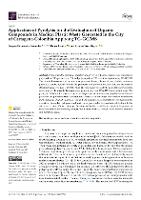Abstract
In this study, the thermal degradation and pyrolysis of hospital plastic waste consisting of polyethylene (PE), polystyrene (PS), and polypropylene (PP) were investigated using TG-GC/MS. The identified molecules with the functional groups of alkanes, alkenes, alkynes, alcohols, aromatics, phenols, CO and CO2 were found in the gas stream from pyrolysis and oxidation, and are chemical structures with derivatives of aromatic rings. They are mainly related to the degradation of PS hospital waste, and the alkanes and alkenes groups originate mainly from PP and PE-based medical waste. The pyrolysis of this hospital waste did not show the presence of derivatives of polychlorinated dibenzo p-dioxins and polychlorinated dibenzofurans, which is an advantage over classical incineration methodologies. CO, CO2
, phenol, acetic acid and benzoic acid concentrations were higher in the gases from the oxidative degradation than in those generated in the pyrolysis with helium. In this article, we propose different pathways of reaction mechanisms that allow us to explain the presence of molecules with other functional groups, such as alkanes, alkenes, carboxylic acids, alcohols, aromatics and permanent gases.














